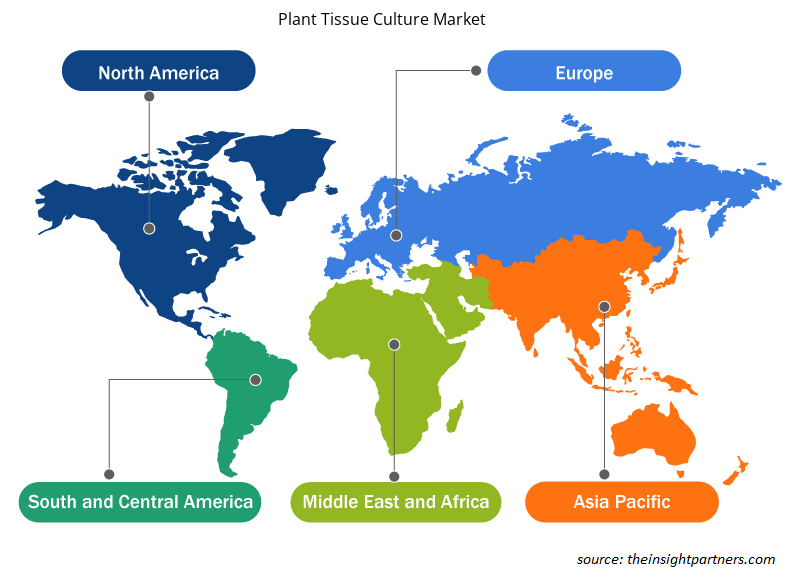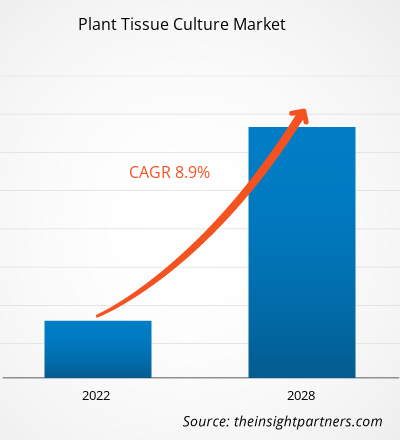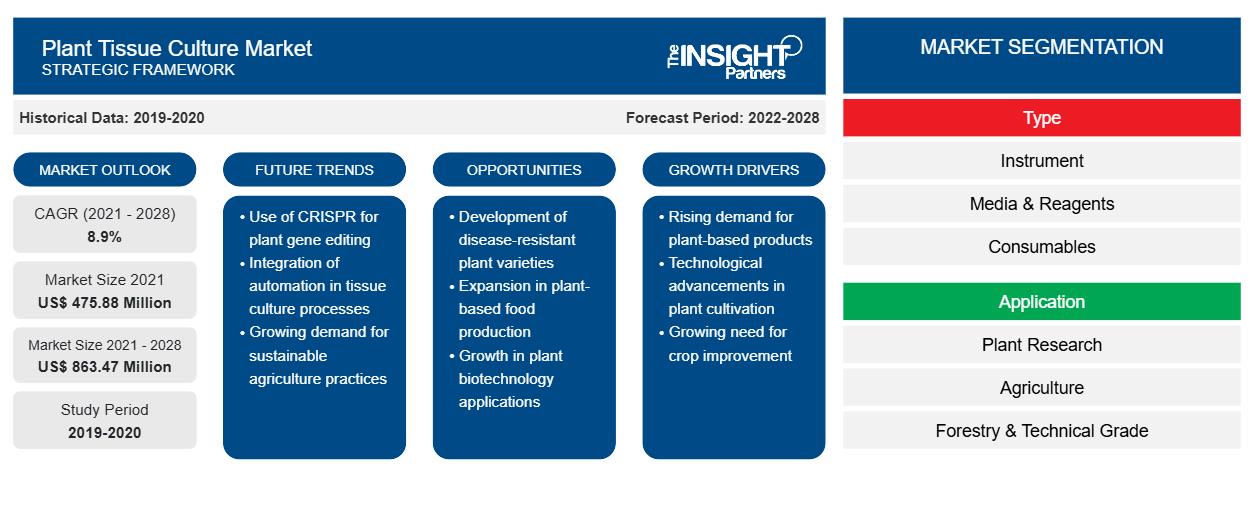[Informe de investigación] El mercado de cultivo de tejidos vegetales se valoró en US$ 475,88 millones en 2021; se espera que crezca a una CAGR del 8,9% entre 2022 y 2028.
El cultivo de tejidos vegetales es un conjunto de técnicas que se utilizan para cultivar células, tejidos u órganos vegetales en condiciones in vitro en un medio de cultivo de composición conocida. Se pueden producir clones de plantas mediante micropropagación. El cultivo de tejidos permite la producción de materiales de plantación de alta calidad y libres de enfermedades. También facilita el crecimiento rápido y uniforme de las plantas. La creciente demanda de plantas transgénicas y la proliferación de la floricultura son los factores clave que impulsan el crecimiento del mercado. Sin embargo, el alto costo de los procedimientos de cultivo de tejidos obstaculiza el progreso del mercado.
El mercado de cultivo de tejidos vegetales se analiza en función de la tecnología, la aplicación, el material y la geografía. El informe ofrece información y un análisis en profundidad del mercado de cultivo de tejidos vegetales, haciendo hincapié en varios parámetros como las tendencias del mercado, los avances tecnológicos y la dinámica del mercado, y el análisis del panorama competitivo de los principales actores del mercado.
Personalice este informe según sus necesidades
Obtendrá personalización en cualquier informe, sin cargo, incluidas partes de este informe o análisis a nivel de país, paquete de datos de Excel, así como también grandes ofertas y descuentos para empresas emergentes y universidades.
-
Obtenga las principales tendencias clave del mercado de este informe.Esta muestra GRATUITA incluirá análisis de datos, desde tendencias del mercado hasta estimaciones y pronósticos.
Perspectivas del mercado
La creciente demanda de plantas transgénicas impulsa el crecimiento del mercado de cultivo de tejidos vegetales
Las plantas transgénicas son aquellas cuyo ADN se modifica mediante técnicas de ingeniería genética para introducir en la planta una característica nueva que no se da de forma natural. Estas plantas transgénicas se generan mediante técnicas de ingeniería genética en el laboratorio alterando la composición genética, normalmente añadiendo uno o más genes al genoma de una planta. Las plantas transgénicas se desarrollan principalmente para proporcionar los nutrientes necesarios y hacer frente a la demanda mundial de alimentos.
Millones de personas padecen desnutrición, que es más frecuente en los países en desarrollo y subdesarrollados. Según la Organización Mundial de la Salud (OMS), en 2019, aproximadamente 462 millones de personas tenían bajo peso. Según UNICEF, casi la mitad de todas las muertes de niños menores de cinco años se atribuyen a la desnutrición. Además, en 2020, alrededor de 45,4 millones de niños menores de cinco años sufrían emaciación, y alrededor de 13,6 millones de ellos sufrían emaciación severa. Según Global Change Data Lab, en 2019, el 8,9% de la población mundial estaba desnutrida. Las personas desnutridas son aquellas que tienen una ingesta calórica por debajo de los requisitos mínimos de energía. Los investigadores se están centrando en el desarrollo de plantas transgénicas que proporcionen las calorías necesarias para satisfacer estos requisitos calóricos. La demanda de plantas transgénicas está impulsando el crecimiento del mercado de cultivo de tejidos vegetales.undernutrition. Moreover, in 2020, about 45.4 million children under the age of five were wasted, and about 13.6 million out of these were severely wasted. According to Global Change Data Lab, in 2019, 8.9% of the world’s population was undernourished. Undernourished people are those who have calorie intake below minimum energy requirements. Researchers are focusing on developing transgenic plants that provide the required calories to meet these calorie requirements. The demand for transgenic plants is fueling the growth of the plant tissue culture market.
Perspectivas basadas en tipos
Según el tipo, el mercado de cultivo de tejidos vegetales se divide en instrumentos, medios y reactivos y consumibles. El segmento de instrumentos tuvo la mayor participación de mercado en 2021. Sin embargo, se espera que el segmento de consumibles registre la CAGR más alta durante el período de pronóstico. Los instrumentos utilizados en el cultivo de tejidos vegetales incluyen refrigeradores, plantas de destilación, sistemas de flujo de aire laminar, balanzas, incubadoras, centrífugas, esterilizadores, etc.CAGR during the forecast period. Instruments used in plant tissue culture include refrigerators, distillation plants, laminar air flow systems, weighing balance, incubators, centrifuges, sterilizers, etc.
Perspectivas basadas en aplicaciones
Según la aplicación, el mercado de cultivo de tejidos vegetales se segmenta en investigación vegetal, agricultura, silvicultura y grado técnico, entre otros. El segmento agrícola representó la mayor participación del mercado en 2021. Sin embargo, se espera que el segmento de investigación vegetal registre la CAGR más alta durante 2022-2028.CAGR during 2022–2028.
Información basada en el usuario final
Según el usuario final, el mercado de cultivo de tejidos vegetales se segmenta en invernadero, campo y laboratorio. El segmento de campo tuvo la mayor participación del mercado en 2021. Además, se espera que el mercado de este segmento crezca a una CAGR del 9,2 % durante 2022-2028.
En muchos países, la COVID-19 ha limitado la movilidad de las personas a través de las fronteras y los confinamientos han contribuido a la escasez de mano de obra en los sectores agrícolas, en particular los caracterizados por períodos de máxima demanda de mano de obra estacional o de producción intensiva en mano de obra. Por ejemplo, las prohibiciones de viajar dentro de la Unión Europea, así como el cierre del Espacio Schengen, han reducido significativamente la mano de obra disponible para el sector de frutas y hortalizas en muchos de los países europeos. La escasez de mano de obra ha provocado pérdidas de producción y escasez en el mercado. La emergencia de la COVID-19 ha perjudicado la logística, la distribución y las cadenas de suministro de productos hortícolas. Esto ha creado inseguridad alimentaria, debido a las interrupciones en la cadena de suministro de productos agrícolas y, en consecuencia, gran parte de la población ha tenido dificultades para acceder a alimentos frescos a precios razonables. Estos factores han tenido un grave impacto en la industria general del cultivo de tejidos vegetales.
Perspectivas regionales del mercado de cultivo de tejidos vegetales
Los analistas de Insight Partners explicaron en detalle las tendencias y los factores regionales que influyen en el mercado de cultivo de tejidos vegetales durante el período de pronóstico. Esta sección también analiza los segmentos y la geografía del mercado de cultivo de tejidos vegetales en América del Norte, Europa, Asia Pacífico, Oriente Medio y África, y América del Sur y Central.

- Obtenga datos regionales específicos para el mercado de cultivo de tejidos vegetales
Alcance del informe sobre el mercado de cultivo de tejidos vegetales
| Atributo del informe | Detalles |
|---|---|
| Tamaño del mercado en 2021 | US$ 475,88 millones |
| Tamaño del mercado en 2028 | US$ 863,47 millones |
| CAGR global (2021-2028) | 8,9% |
| Datos históricos | 2019-2020 |
| Período de pronóstico | 2022-2028 |
| Segmentos cubiertos |
Por tipo
|
| Regiones y países cubiertos |
América del norte
|
| Líderes del mercado y perfiles de empresas clave |
|
Densidad de actores del mercado de cultivo de tejidos vegetales: comprensión de su impacto en la dinámica empresarial
El mercado de cultivo de tejidos vegetales está creciendo rápidamente, impulsado por la creciente demanda de los usuarios finales debido a factores como la evolución de las preferencias de los consumidores, los avances tecnológicos y una mayor conciencia de los beneficios del producto. A medida que aumenta la demanda, las empresas amplían sus ofertas, innovan para satisfacer las necesidades de los consumidores y aprovechan las tendencias emergentes, lo que impulsa aún más el crecimiento del mercado.
La densidad de actores del mercado se refiere a la distribución de las empresas o firmas que operan dentro de un mercado o industria en particular. Indica cuántos competidores (actores del mercado) están presentes en un espacio de mercado determinado en relación con su tamaño o valor total de mercado.
Las principales empresas que operan en el mercado de cultivo de tejidos vegetales son:
- Corporación Internacional Segra
- Viveros JRT Inc.
- Thomas Scientific LLC
- Compañía Sigma-Aldrich LLC
- Laboratorios HiMedia Pvt Ltd
Descargo de responsabilidad : Las empresas enumeradas anteriormente no están clasificadas en ningún orden particular.

- Obtenga una descripción general de los principales actores clave del mercado de cultivo de tejidos vegetales
En 2022, América del Norte tuvo la mayor participación en el mercado de cultivo de tejidos vegetales. El crecimiento del mercado en esta región se atribuye a un aumento en las actividades de investigación y desarrollo en el campo del cultivo de tejidos. Además, se espera que Asia Pacífico registre la CAGR más rápida durante el período de pronóstico. China, Japón e India son los principales contribuyentes al mercado de cultivo de tejidos vegetales en esta región. El crecimiento del mercado en APAC se atribuye al aumento de las inversiones gubernamentales en la promoción de la investigación basada en el cultivo de tejidos, el aumento de las escalas de adopción de tecnologías avanzadas y las mejoras en la infraestructura que respalda a los laboratorios de cultivo de tejidos.
Por geografía, el mercado de cultivo de tejidos vegetales está segmentado en América del Norte (EE. UU., Canadá y México), Europa (Reino Unido, Alemania, Francia, Italia, España y el resto de Europa), Asia Pacífico (China, Japón, India, Corea del Sur, Australia, resto de Asia Pacífico), Medio Oriente y África (EAU, Arabia Saudita, África y el resto de Medio Oriente y África) y América del Sur y Central (Brasil, Argentina y el resto de América del Sur y Central).
Perfiles de empresas
- Corporación Internacional Segra
- Viveros JRT Inc.
- Thomas Scientific LLC
- Compañía Sigma-Aldrich LLC
- Laboratorios HiMedia Pvt Ltd
- Laboratorios Caisson Inc.
- Laboratorios Alpha Ltd.
- Becton Dickinson y compañía
- Laboratorio de cultivo de tejidos de AL-Rajhi
- Marioneta Al Wathba LLC
- Análisis histórico (2 años), año base, pronóstico (7 años) con CAGR
- Análisis PEST y FODA
- Tamaño del mercado, valor/volumen: global, regional y nacional
- Industria y panorama competitivo
- Conjunto de datos de Excel
Informes recientes
Testimonios
Razón para comprar
- Toma de decisiones informada
- Comprensión de la dinámica del mercado
- Análisis competitivo
- Información sobre clientes
- Pronósticos del mercado
- Mitigación de riesgos
- Planificación estratégica
- Justificación de la inversión
- Identificación de mercados emergentes
- Mejora de las estrategias de marketing
- Impulso de la eficiencia operativa
- Alineación con las tendencias regulatorias























 Obtenga una muestra gratuita para - Mercado de cultivo de tejidos vegetales
Obtenga una muestra gratuita para - Mercado de cultivo de tejidos vegetales